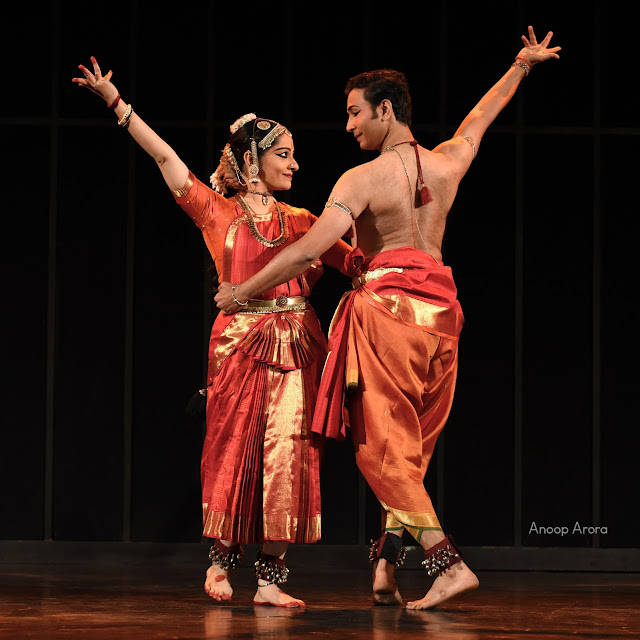 |
Parvathy Menon and Shijith Nambiar (Pic: Anoop Arora)
|
Aagman, a festival of classical dance and music, was organized by Sangeet Vidya Niketan at IHC Delhi from 4th to 10th April. It was an immense effort by the young organizers of SVN to put up the festival with the support of IHC as their venue and hospitality partner and AirAsia as their travel partner. The aim of the festival was to engage, support and present young artistes. In the foyer was an exhibition of photographs of young masters of dance and music clicked by veteran photographer Avinash Pasricha. His prints can still make you catch your breath because he can capture stills in a live performance like no other. On 9 and 10 April, there was a pottery exhibition called 'Elixir of Life' by Priyanka Sharma. The varied pottery pieces were quite original in shape and size. Besides that, there were workshops over the course of the festival in Kathak and Hindustani music, a daily mangal gaan by the children of Salaam Baalak Trust, and screening of the film 'Kala Upasana'. In their Meet the Maestros series, there were senior gurus who came to enlighten the students: Pt Suresh Talwalkar, Darshana Jhaveri, Kumkum Lal, Shruti Sidolkar and G. Venu.
 |
Madhur Gupta (Pic: Anoop Arora)
|
The concert series on 9 and 10 April was conducted with great poise and verbal expertise by the lovely Divya Goswami. The foyer and the stage had the pleasant scent of rajnigandha flowers. On day 1, the first to take the stage was Aditya Khandwe. He presented raag Bhoop, "Jab mein jaani," a madhyalaya bandish in teen taal, "Jab se tum sang laagli," and a tarana in drut teen taal. The next piece was a madhyalaya bandish in raag Basant, composed by Pandir Dinkar Kaikini of the Agra gharana, "Kanha rangwa na daro," a tarana in drut teentaal. He was accompanied by Atmaram Bicholkar on the harmonium and Akshay Jadhav on tabla.
 |
| Aditya Khandwe (Pic: Anoop Arora) | | |
Next on stage was Madhur Gupta, disciple of Sharon Lowen. He has
previously trained under Madhavi Mudgal and Bichitrananda Swain. For
this performance, he wore a white Odia sari as a dhoti.
 |
Madhur Gupta (Pic: Anoop Arora)
|
 |
| Madhur Gupta (Pic: Anoop Arora) |
He began with a mangalacharan in raga Malkauns, Bageshwari and Durga, ektali and triputa. It was a choreographic work of Guru Kelucharan Mohapatra, an ode to Matangi, "Manikya veena dhari." Matangi, the daughter of Rishi Matang, is the tantric avatar of goddess Saraswati. Mother Matangi controls speech, music, knowledge and the arts. She holds a bejewelled veena and is four-armed, with the graceful gait of an elephant. Madhur addressed the piece with grace, depicting her various attributes and ornaments. After an ode to Lord Jagannath and a traditional invocation of mother earth, the sound of the melody of the flute filled the auditorium. His body swayed gracefully in tribhanga. In a chauka and a squat, he rose on his toes.
 |
Madhur Gupta (Pic: Anoop Arora)
|
Next was a pallavi in raga Jaijaiwanti, taal ektali. The pallavi is a lyrical elaboration of pure dance. Intricate patterns of rhythm are woven into music and movement. This was choreographed by Madhur. Madhur's hastas were very clean, footwork was accurate. The chakkars were completed on one foot. He ended the piece with pace, grace and leaps. The third piece was a 'jha' champu in raga Pilu, tala khemta, with every line beginning with 'jha'. The choreography was by Guru Sharon Lowen. Sakhi Lalita sees Krishna devastated by not being able to be with Radha. Madhur gives a different interpretation of the condition of Krishna in a state of viraha. Lalita comes asking for Krishna and finds him in a state of despair. She distracts him, gets him to put his ornaments back and asks him to come with her to Radha.
 |
Madhur Gupta (Pic: Anoop Arora)
|
The last piece was Madhur's dive into abhinaya. This piece is a recently revived choreography of Guru Kelucharan Mohapatra, ashtapadi "Yami he kamiha sharanam." It was choreographed by guruji in 1979 with the help of the scholar Jiwan Pani. It was recomposed by Pt. Bhubaneshwar Mishra in raag Mishra Khamaj, and taught to Madhur by Guru Kumkum Lal. The translation says that the moon has risen and the moonlit forest is not suitable for the union. Krishna is still not here and Radha laments. Madhur went on to show with very sensitive emoting, the dejection and deception that Radha feels. Radha cannot even trust her friends and take refuge in them. She feels her beauty and youth is totally wasted. Radha moves among the creepers. She has bolted her house and left for the forest. There are thorns in her path and she is afraid of the serpents. And yet, her determination to meet him is unfaded. Her heart is bearing all the arrows that are showered at her. If he is with another woman, then all my ornaments are a waste, she laments, and she begins to remove her ornaments. "Hari bin dushan bhushan" she says as she removes her ornaments. She reminisces about the time that she kissed the lotus face, and finally falls down in viraha. Madhur almost lived the piece as he portrayed experiencing the pangs of separation and the acute anguish it brings ('sa paritapam').
 |
Madhur Gupta (Pic: Anoop Arora)
|
Madhur's excellent accompanists were Prafulla Mangaraj on mardala, Ketki Singh on vocals, Nikhil Kumar on flute, Prashant Kumar on tanpura and Smita Babar on manjira. The performance belonged as much to the accompanists as to Madhur.
 |
Shruti Adhikari and her son (Pic: Anoop Arora)
|
The second evening began with Shruti Adhikari and her grandson playing the raag Puriyakalyani on the santoor. The soothing, tinkling melody of the santoor was a welcome respite after a long drive through the city. While Shruti's soft notes were soothing, her son and disciple Ninad brought energy to the taal.
 |
| Shijith Nambiar and Parvathy Menon (Pic: Anoop Arora) |
 |
| Shijith Nambiar and Parvathy Menon (Pic: Anoop Arora) |
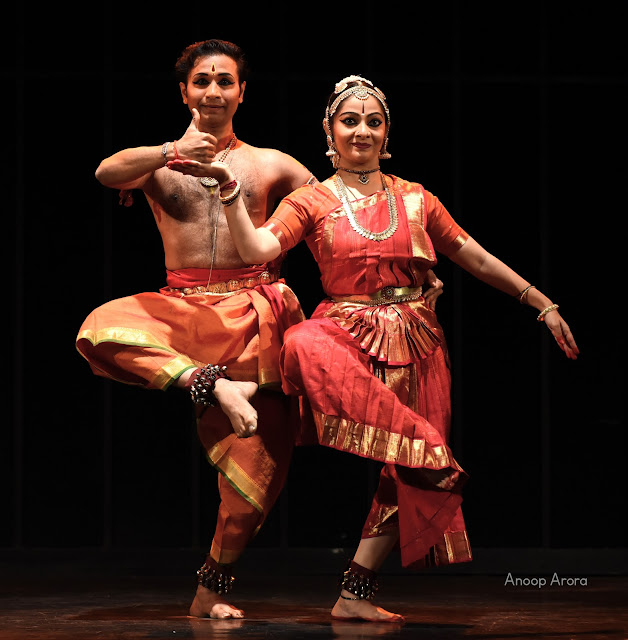 |
| Shijith Nambiar and Parvathy Menon (Pic: Anoop Arora) |
The second performance of the last day was Bharatanatyam by Shijith Nambiar and Parvathy Menon. The couple was so agile, so graceful, so perfect in technique and so expressive in their abhinaya that taking your eyes off them was difficult. Parvathy in her red aharyam and Shijith in his yellow dhoti were the very picture of soundaryam on a stark stage with the ceremonial lamp, and a few rajnigandha flowers. As it is, watching a live performance in Stein Auditorium is an experience, since the dancers are pretty close to the spectators. They were accompanied by Saji Lal on nattuvangam, Binu Venugopal on vocals, Shivaprasad on mridangam and Easwar Ramakrishnan on violin. The vocalist began with a Ganesh Stuti, which was indeed very melodious. The violinist also made a mark.
 |
Shijith Nambiar and Parvathy Menon (Pic: Anoop Arora)
|
The first piece they performed was Adi Shankaracharya's 'Ardhanarishwar strotam'. The music has been given by Rajkumar Bharati in ragam Brindavana Sarang, and choreographed by Shijith and Parvathy. This is a piece that is oft visited in all forms of dance. But the duo breathed novelty and life into it by choreographing it as a duet. The lyrics describe the ardhanarishwar form of Shiva and Parvati, who are two opposite seats of power.
One has the complexion of a champa flower, the other half is like camphor; one has beautiful, cascading hair, while the other has matted hair. One is adorned with kasturi and sandal paste, while the other smears the ash of the funeral pyre. One brings to life Kamadev, the other destroys him with his third eye. Parvati has anklets on her feet and Shiva has snakes wound around them. She has ornaments on her arms and he has snakes wound around them; she wears the divine garland and he wears the garland of skulls. She wears a beautiful sari and Shiva is digambara (no clothes). Her locks are the colour of black clouds and his like the lightning and red. Her dance, lasya, is the one which gives rise to srishti-creation, and his dance, tandav is for sanhar or destruction. They are the mother and the father of all creation. Parvati wears earrings of precious stones and Shiva has snakes all over him as ornaments. She is shiv maye and Shiva is shakti maye; they are both united to form one.
 |
| Shijith Nambiar and Parvathy Menon (Pic: Anoop Arora) |
The lyrics are so imaginative that every word has its import. Shijith and Parvathy executed this piece with such elan. With Shijith standing behind Parvathy, they alternately showed his and her attributes. The jatis were power-packed, with leaps and movements left and right, forward and back, alternating or together. Parvathy showed the lasya element and Shijith the tandav. And for the refrain, they would come together from all directions to show the Shiva and the Shakti. Finally, they culminated by holding each other by the waist and moving around while showing the attributes of Shiva and Shakti. The piece came to show its title, 'Alingan'. As Divya had mentioned in the beginning, the chemistry between them was visible and so was the continuity of the soul between two individuals.
 |
| Shijith Nambiar and Parvathy Menon (Pic: Anoop Arora) |
The next piece was a jathiswaram with sahityam on Lord Padmanabha, composed by Maharaja Swati Tirunal in Pancha Ragamalika, set to mishra chapu talam. The choreography is by the dancers. It was again a power packed performance. The violinist did an excellent job at the start of the piece. The dancers depicted Lord Padmanabha reclining on the snake Adisesha, Shijith as the lord and Parvathy as the bhakta, sitting with clasped hands. Next, it was Lord Rama who was shown as holding his bow and arrow, and then Lord Krishna was shown to save the drowning Vraja as Indra drowned it in incessant rain. It was the jatis that wove the magic, the stretches and leaps almost like the baat-cheet in Kathak. They covered the entire stage as they moved in awe inspiring coordination. The pace, the agility, the leaps and the leg lifts were all magical.
 |
| Parvathy Menon (Pic: Anoop Arora) |
Jayadeva's ashtapadi, 'Sa virahe tav deena' in ragam Ahir Bhairav composed by Edapally Ajith was presented solo by Parvathy. The sakhi relates to Krishna how Radha has totally lost herself in viraha. The arrows of separation are painful for her. She has no control on the emotions that she experiences. She is trying to meditate to get over this pain. The moon burns her, the cool breeze and the sandalwood scent heightens her pain. Since you reside in her heart, she says, she protects it with moist lotus petals. On her lotus face are streaks of tears, as if the moon has been subjected to an eclipse. That is the intensity of viraha that you have given her. Radha paints a picture of you, she pays obeisance to you. Your indifference is becoming unbearable to her. She then resorts to meditating on you and finds you there. These lyrics describe the intensity of Radha's viraha in its totality. The words can seep into your thoughts and make you a part of the anguish that Radha is experiencing. The musicality of the piece, the vocals and Parvathy's depiction sent waves of pangs of viraha and filled your eyes with tears.
 |
| Parvathy Menon (Pic: Anoop Arora) |
 |
| Parvathy Menon (Pic: Anoop Arora) |
Parvathy depicted Radha in a delusional state while the sakhi goes out in the night in the bowers to look for Krishna. Some poignant moments were when Radha tells her that the malayasameer stings her like snakes. Parvathy depicted Radha as seeing illusions of Krishna approaching, sometimes jubilant, sometimes despondent. As she asks the sakhi about Krishna, in her false hope, she puts on the ornaments and waits for him. In disappointment, she stares at the path stone-eyed, breaks down, imagines him standing there and embraces the creeper and runs around to look for him. On the banks of the Yamuna, as she draws him on the earth, she embraces the picture and finally surrenders to dhyana of Hari to find solace. Parvathy poured her soul into every gesture of this abhinaya piece, covering her face in despair in an effective display of viraha.
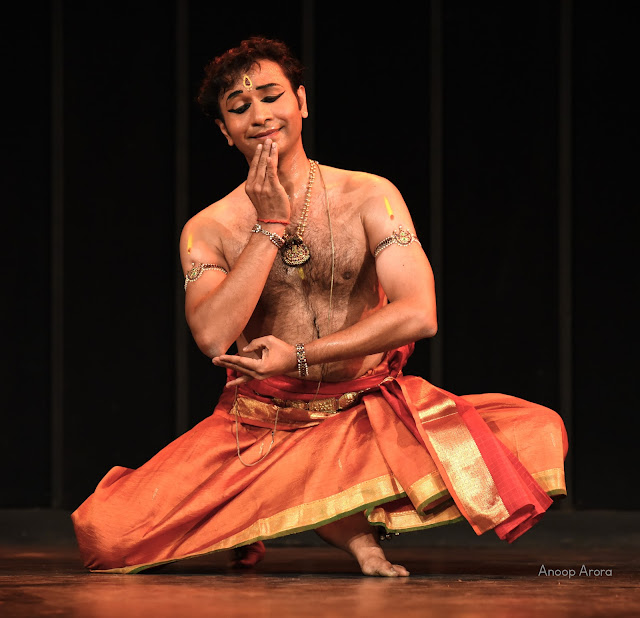 |
Shijith Nambiar (Pic: Anoop Arora)
|
Shijith seemed to thoroughly enjoy the dancing. Every adavu and jati was completely effortless, as if it came naturally to him, and he was like a fish in water. For his solo, he performed 'Sami Mayura Giri Vadivela' in ragam Khamas, adi talam. Composed by Kavi Kunjara Bharathi, the composition is about the peacock who is the vahana (vehicle) of Lord Kartikeya and the protagonist in this piece. The peacock wakes up in the morning and opens up his plumage a little.
 |
| Shijith Nambiar (Pic: Anoop Arora) |
Shijith moved his torso in various contortions to show the mayura (peacock) waking up. He sees his master coming, and with pleasure in his eyes, he opens up a little more. The mayura readies to carry his swami, looks into the mirror and perfects the feathers in his crown. He dances to drums with his beak upward in joy. Kartikeya caresses him and puts the tilak on his forehead. The mayura spreads his plumage and Kartikeya mounts him. In his excitement, the mayura leaps around and the lord disciplines him, making him cringe. He feels resigned and wipes his tears as he reminisces how Kartikeya had saved him. His heart flutters and he is scared. Kartikeya finally opens his doors, lets him in and embraces him. The mayura dances with joy.
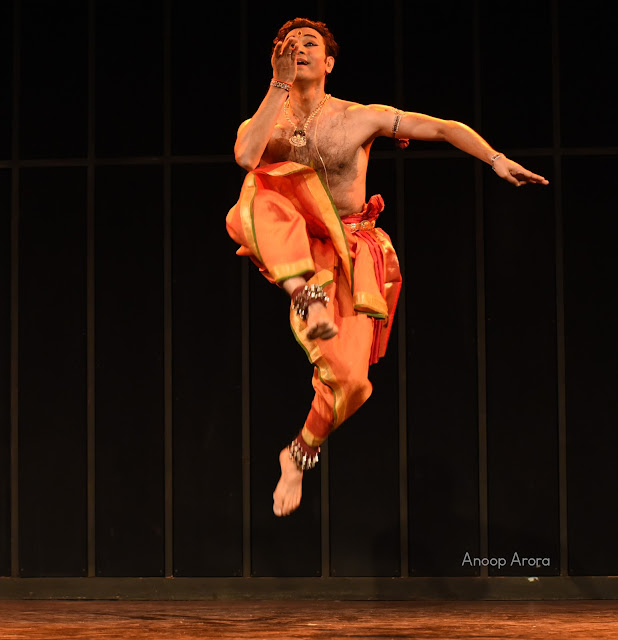 |
| Shijith Nambiar (Pic: Anoop Arora) |
Shijith took massive leaps to portray the peacock's joy. Kartikeya rides on him to a temple where Valli resides. He signals to the mayura to stop, but his gaze follows him. He sees a few people inside and then he sees Kartikeya and Valli holding hands and embracing. When Kartikeya comes out, the peacock raises inquisitive eyes and points towards Valli. Kartikeya is in no mood for jokes and pulls his ears. The peacock threatens to spread the word. And then they reach a truce: neither will the peacock tell anyone, nor will Kartikeya mount anyone else.
 |
| Shijith Nambiar (Pic: Anoop Arora) |
Shijith's ekaharya abhinaya was done very expressively. No two movements of the peacock were the same. I thought he moved his torso, neck and shoulders in so many ways and so energetically that he could have done himself an injury. It was a riveting piece. The gestures were all immaculately done.
 |
| Shijith Nambiar and Parvathy Menon (Pic: Anoop Arora) |
 |
| Shijith Nambiar and Parvathy Menon (Pic: Anoop Arora) |
The concluding thillana in ragam Chenjurutti, talam adi, with music by Veenai Seshanna was all about the chemistry of the two dancers. The jatis were performed facing each other, back to front, going in one direction or the opposite, even diagonally opposing. There was sideward foot kicking and clapping. They performed nritta together or one after the other, where Shijith brought in the masculine energy and Parvathy the grace element. The thillana was an ode to Krishna. And it appeared that as a couple, they were exchanging loving banter with each other. I feel like thanking them for giving so much pleasure to dance lovers.
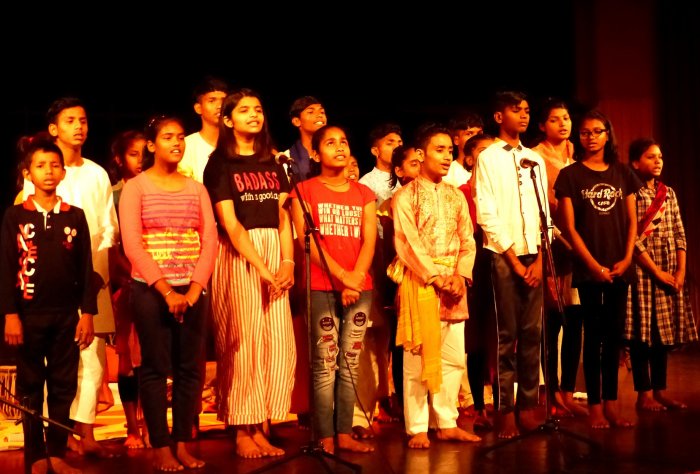 |
| Children of Salaam Baalak Trust (Pic: Avinash Pasricha) |
Note: This article first appeared in narthaki.com



























dance online
ReplyDelete